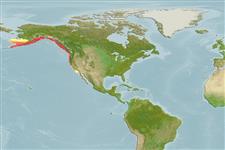Preferred temperature (Ref.
115969): 4.5 - 8.6, mean 5.9 (based on 184 cells).
Phylogenetic diversity index (Ref.
82804): PD
50 = 1.0002 [Uniqueness, from 0.5 = low to 2.0 = high].
Bayesian length-weight: a=0.00389 (0.00180 - 0.00842), b=3.12 (2.94 - 3.30), in cm Total Length, based on all LWR estimates for this body shape (Ref.
93245).
Trophic level (Ref.
69278): 4.5 ±0.6 se; based on diet studies.
Widerstandsfähigkeit (Ref.
120179): mittel, Verdopplung der Population dauert 1,4 - 4,4 Jahre. (tm=4; tmax=25;).
Prior r = 0.48, 95% CL = 0.32 - 0.73, Based on 1 stock assessment.
Fishing Vulnerability (Ref.
59153): High vulnerability (56 of 100).
Climate Vulnerability (Ref.
125649): Moderate to high vulnerability (48 of 100).
